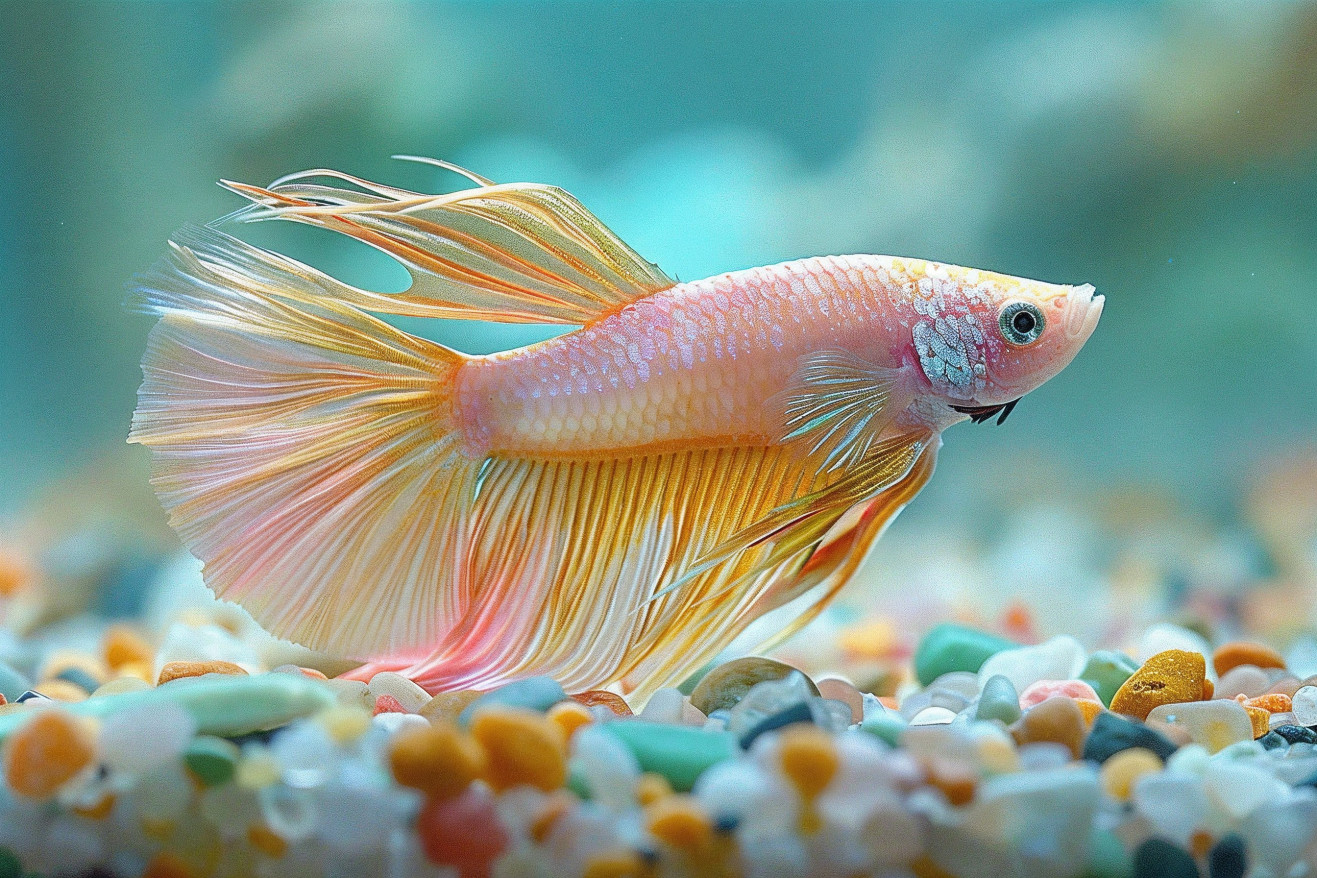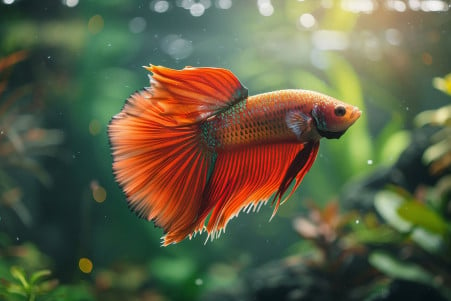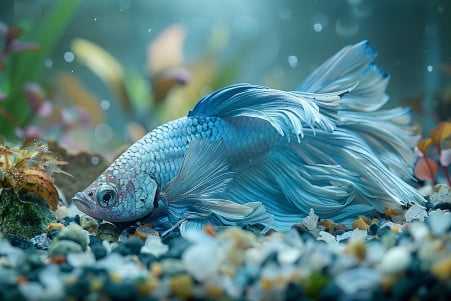Why Is My Betta Fish Laying at the Bottom of the Tank? Decoding Betta Behavior
6 May 2024 • Updated 6 May 2024

If your betta fish is hanging out at the bottom of the tank and seems lethargic or inactive, there are a few different things that could be causing this behavior. One of the most common reasons betta fish will stay at the bottom of the tank is poor water quality, but it could also be due to stress from things like water temperature, low oxygen, ammonia, or even the presence of other fish or decorations.
We'll look at research from both aquatic biology and fish behavior experts to explore the many reasons why your betta fish might be spending more time at the bottom of the tank than usual. This way, you can make sure you're doing everything you can to create the best environment for your betta fish, so it can swim around and be the active, engaging pet you want it to be.
Why is my betta fish laying at the bottom of the tank?
Water Quality Problems and Their Impact
One of the most common reasons bettas lie at the bottom of the tank is poor water quality. High levels of ammonia, nitrite, and nitrate can cause stress and illness in bettas, according to AquariumSource. Ammonia and nitrite are particularly dangerous and can lead to rapid gill movement, listlessness, and other abnormal behaviors.
It’s important to test your water regularly to ensure that you’re maintaining the right levels for your betta. As Tropicflow notes, bettas need water with 0 ppm ammonia, 0 ppm nitrite, and nitrates that are less than 20 ppm. Good bacteria are responsible for breaking down waste and regulating the levels of ammonia and nitrites in the water through the nitrogen cycle.
To ensure that your water quality stays high, make sure to do regular 25-50% water changes every week, vacuum the gravel to remove waste, and use a high-quality dechlorinator to remove chlorine and chloramines from the water. As USBetta says, poor water quality can lead to a betta’s immune system being compromised, which can lead to stress and sickness, which can lead to bottom-dwelling behavior. Regular water testing and maintenance are key to keeping your betta healthy.
The Right Tank Setup and Environment
Bettas need a certain type of tank setup to be able to live comfortably and display their natural behaviors. According to Fantasea Aquariums, the smallest tank size that should be used for a betta is 5 gallons. Anything smaller than 5 gallons can be problematic because it's hard to keep the water parameters stable and can cause stress and health problems for the betta.
It's important to keep the water in the tropical range of 75-80°F. PNW Bettas notes that bettas are labyrinth fish and need to be able to breathe from the surface, so a heater is a must.
In addition to the heater, the tank needs to have a gentle filter and surface agitation to ensure proper gas exchange, according to Bettaboxx. The right tank decor and hiding places can also help lower stress and make sure the betta is getting the enrichment it needs to show natural swimming behaviors.
How to Tell If Your Betta Fish Is Stressed or Sick
Bettas display certain behaviors when they are stressed or sick. According to USBetta, some of the most common signs of stress include pale coloration, clamped fins, loss of appetite, and hiding. In addition, PetHelpful notes that stressed bettas may also exhibit "glass surfing," which involves swimming frantically up and down the tank walls.
Chronic stress also suppresses a betta's immune system, leaving it vulnerable to diseases like fin rot, ich, and velvet, all of which can lead to lethargy, according to BeChewy. These diseases can also cause a betta to stay at the bottom of the tank. That said, it's important to recognize the early signs of stress and address the root causes as soon as possible to prevent health issues and ensure a happy, healthy, and active betta.
Mental Stimulation and Socialization
Bettas are smart fish that require mental stimulation and social interaction. As Betta Fish Care explains, bettas in the wild inhabit large, shallow bodies of water, so they are less territorial than their tank-dwelling counterparts. Adding live plants, caves, and other tank decorations can help stimulate natural exploration and hiding behaviors, which can help reduce stress and boredom.
For mental stimulation, Aqueon recommends training bettas to follow a target or push a ping-pong ball. These types of mental exercises can help keep bettas mentally stimulated and encourage healthy swimming. As Aquarium Co-Op points out, these exercises can help prevent boredom and encourage natural behaviors.
When adding new things to the tank, it's important to make changes slowly so as not to stress the betta. This will help ensure a smooth transition and prevent stress-related lethargy. For example, make sure to slowly introduce the fish to changes in the tank's environment or new interactive toys.
How Swim Bladder Disease Is Diagnosed and Treated
Swim bladder disease is a common condition that affects a betta's buoyancy and swimming ability. According to Bettafish.org, bettas suffering from swim bladder disease may exhibit a variety of symptoms related to their ability to swim and remain buoyant, including floating to the top, sinking to the bottom, swimming vertically or on their sides, and having a swollen abdomen.
The most common cause of swim bladder disease is digestive problems, as BeChewy explains. Overfeeding, constipation, and gulping down air can all lead to the swim bladder becoming impacted or compressed. Low water temperature, sudden environmental changes, physical trauma, and infections can also contribute to swim bladder issues.
Treatment will depend on the cause of the disease. If the disease is caused by digestive problems, FishLab recommends fasting the betta for 3 days and then feeding daphnia or blanched peas. Meanwhile, bacterial or parasitic infections may require antibiotics. It's important to note that regardless of the cause, maintaining stable water conditions and ensuring the betta has access to plenty of oxygen will be important for helping the fish recover. In general, the sooner swim bladder disease is diagnosed and treated, the better the prognosis will be for the betta.
Proper Acclimation and Introduction to a New Tank
Acclimating a new betta to its tank is important to help the fish feel comfortable and reduce stress. According to Bettaboxx, this process includes floating the bag the betta came in in the tank for 10-15 minutes and then adding small amounts of tank water to the bag every 5-10 minutes for 25-30 minutes. This will help the betta adjust to the new water parameters and temperature.
As wikiHow notes, it's important to take your time with this process because if you rush it, you could stress the fish. After the acclimation process, release the betta into the tank. Josh's Frogs suggests setting up the tank and making sure it's fully cycled before you bring the betta home so that it's ready to go when the fish arrives.
When you introduce the betta to the tank, make sure to watch it closely for the first 24 hours to see if it's showing any signs of stress, such as lethargy, clamped fins, or a lack of appetite. If you notice any of these signs, it's important to address them right away so that the betta can adjust to its new environment and won't start bottom-sitting.
Conclusion: How to Set Up the Best Betta Tank
There are many reasons why bettas may be hanging out at the bottom of their tanks, including poor water quality, tank setup, stress, illness, and acclimation. It's important to know what's causing your betta to stay at the bottom of the tank so that you can address it and help your fish be more active.
To make sure that your betta is in the best environment, you'll want to make sure that you're regularly testing the water, keeping up with the right tank size and temperature, providing enrichment, and watching your betta for any signs of distress. By being proactive and making sure that your tank is set up to meet your betta's needs, you can have a happy, healthy, and active pet.
When you get the right tank set up, keeping a betta can be a very rewarding experience. With the right knowledge and care, you can set up a tank that will help your betta show off its natural behaviors and bring happiness to your home.


